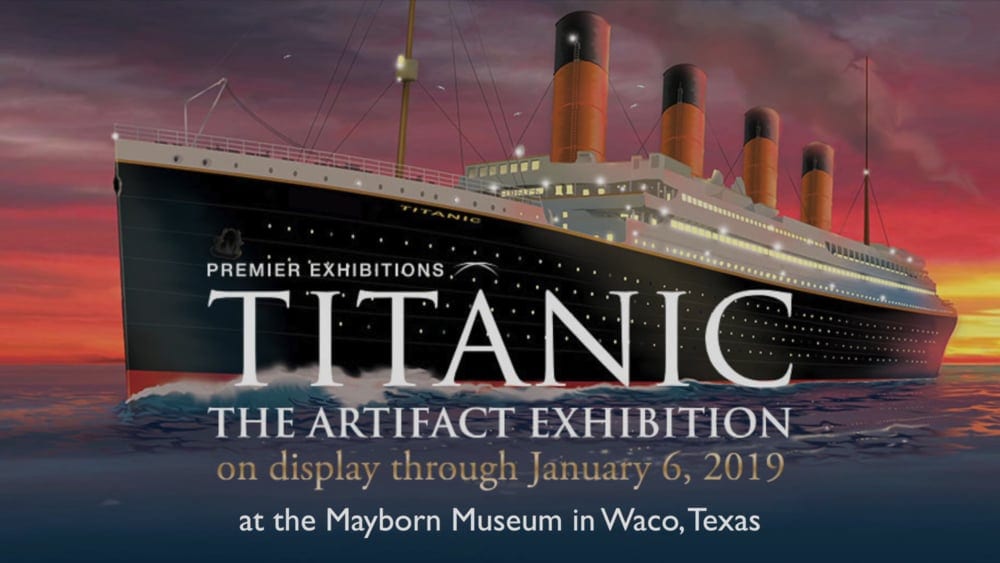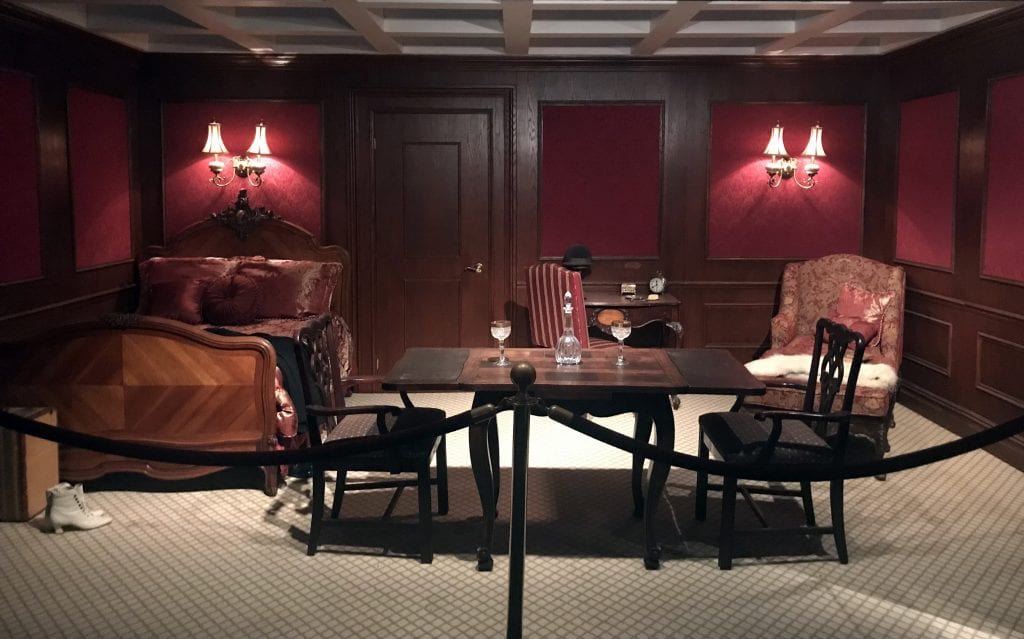By Courtney Doucet
From now until Jan. 6, 2019, people who want to see authentic pieces of the legendary ship Titanic, and learn more about the legendary ocean liner’s incredible story, need travel no further than Waco, Texas.
Baylor University’s Mayborn Museum is hosting “Titanic: The Artifact Exhibition,” which features a collection of more than 150 authentic artifacts recovered from the resting site of Titanic on the Atlantic Ocean floor. I was given the opportunity to see this exhibit, and was pleasantly surprised by how exciting it was to learn about the Titanic from a new perspective — unlike the textbook readings from days gone by that had first taught me its history.
Upon arrival at the Titanic exhibit, I was greeted and given a White Star Line boarding pass with the name and background information of an actual Titanic passenger. The boarding pass detailed the passengers’ name, age, class distinction, where they were from, where they were traveling to and their reason for traveling aboard the Titanic. The bottom of the pass also listed a fact about the passenger. I was given the boarding pass of Miss Eva Miriam Hart, a seven-year-old girl traveling Second Class with her mother and father from Ilford, Essex, England, to Winnipeg, Manitoba, Canada. Eva’s father was moving the family to Canada to profit from the construction boom taking place in Winnipeg.
In the first room of the exhibit, guests learn about the making of the Titanic, the shipping company White Star Line that owned it, the ship’s captain, the Titanic’s launch and its departure.
The Titanic’s construction began in 1909 and involved the work of more than 10,000 men and boys. The steel slabs of the ship were held together by 3 million rivets, 1 million of which were fastened mechanically by a hydraulic hammer. The others that were hard to reach were hammered in by hand. Because of the watertight sealing and remote-controlled doors that would contain flooding in the event of a collision, the Titanic was deemed to be “practically unsinkable.”
I and three other guests moved slowly around the room as we scanned the walls covered with information about the ship. Jovial maritime music filled the dimly lit room, which provided for an unsettling juxtaposition of the passenger’s delight to board the Titanic and the impending doom that was to transpire only a few hours after the ship’s passengers settled into their cabins.
The next room of the exhibit explains the differences between the three passenger groups — First Class, Second Class and Third Class — which were based upon the expense of the tickets purchased for the voyage. The room also details the facilities and conveniences provided for each class.
A display features a full-scale model of what a First Class cabin on the Titanic would look like. I marveled at the rich cherry oak on the bedframe and walls as upbeat Edwardian era music played in the background. A couple joined me in examining the room and I overheard the man say to his partner, “That looks better than our bedroom.”
A display next to the room contains common toiletries that passengers took abroad with them that were recovered near the site of the sunken boat, including a jar of Dagget & Ramsdell Cold Cream that still had cream inside of it (despite being on the bottom of the ocean floor for 80 years). Another display shows several U.S. National Bank Notes that also were in pristine condition despite being underwater. A $10 note was even printed right here in Texas at The City National Bank in Bryan.
Opposite to the model of the cabin are three glass displays that showcase the First, Second and Third Class china sets which were offered to the passengers at mealtimes, much of which were so intact that it did not seem that the pieces had been at the bottom of the ocean for several decades. Although the Third Class china sets were of a lesser quality, they were still high-end considering the standards of modern china. I was amused by the menus for each of the three classes and determined that the Third Class menu of roast pork, sage and onions could still be just as nourishing, albeit not as fancy, as the First-Class’ roast duckling with applesauce.
I stepped out of the second room into a brightly lit, white-paneled hallway, where a full-scale model room of a Third Class cabin is on display.
The narrowness of the hall drowned out the music of the previous room, leaving me in a silence that forced myself to contemplate the reality and complexities of the Edwardian class distinctions of the time.
Instead of the king-sized individual beds draped in the best linens and opulent decor that was customary in the First Class cabins, the Third Class cabins had two sets of bunk beds surrounded by bare walls. Pipes and support beams were the only things that adorned the ceilings. The positioning of the rooms also guaranteed that Third Class passengers felt every single vibration of the engine and movement of the ship. The Titanic only offered two bathtubs for the 700 third-class passengers. Although not near as nice as the grand First Class rooms, the Third Class cabins provided mattresses instead of the straw pallets that were customary of other cruise lines’ Third Class accommodations at the time.
Stepping out of the hallway into the next room, I heard the return of music, now daunting and unnerving, and the low hum of a machine off in the distance. There was also a slight drop in temperature, not enough so that I needed to pull out a jacket, but just enough to make me aware of a cold that can make the hairs of your arms stand at attention.
The walls tell of how the Titanic began to receive warnings throughout the day of April 14, 1912, from other ships and how these warnings unfortunately did not reach the crew in the bridge. At 10:55 p.m. on April 14, an ice warning was issued by the ship Californian, a warning that was not received on the Titanic. By 11:40 p.m., the Titanic had hit an iceberg in the moonless night and dark sea and began to sink.
Rounding the corner, I encountered a replica of an iceberg made of real ice kept solid by a motorized display, which explained the humming of machinery and the chill in the air. A sign on the side of the bluish slab instructs you to touch the iceberg. I did so, only to snatch my hand back seconds later due to the icy sensation. The sign explained how the salt in the ocean at the time of Titanic’s sinking made the water colder than the freshwater replica iceberg before me, and how many of the passengers therefore perished from hypothermia as opposed to drowning.
There are quotes on the wall from survivors that describe their thoughts and reactions to the ship’s sinking. One that stuck out to me came from Second Class passenger Lawrence Beesley, as it put into perspective just how devastatingly quick and abruptly the ship had sunk to the ocean’s floor.
“In place of Titanic we had the level sea now screeching in an unbroken expanse to the horizon, heaving gently as before, with no indication…the waves had just closed over the most wonderful vessel ever built by man’s hand,” Beesley said.
 A few steps around the corner, a display shows rows of au gratin dishes, lined up just as they had been when they were discovered among the debris of the ship. This showing of uniformity amidst devastation, although a tragedy, allows us to memorialize and contemplate the fateful night that this “most wonderful vessel” disappeared under the horizon of the sea. Although there are no more living survivors of the Titanic, exhibits such as these allow future generations to never forget such an important event in the world’s history.
A few steps around the corner, a display shows rows of au gratin dishes, lined up just as they had been when they were discovered among the debris of the ship. This showing of uniformity amidst devastation, although a tragedy, allows us to memorialize and contemplate the fateful night that this “most wonderful vessel” disappeared under the horizon of the sea. Although there are no more living survivors of the Titanic, exhibits such as these allow future generations to never forget such an important event in the world’s history.
In the last room of the exhibit, there is a wall listing the names of every person who sailed aboard the Titanic, organized by class and whether or not they were passengers or crew members. This allowed me to see whether the passenger listed on my boarding pass had survived or died. I was relieved to find Miss Eva Hart’s name and that of her mother among the survivors — but that relief was short-lived once I found her father’s name among those who died. The wall dramatically illustrates the fact that that most Titanic deaths were made up of the Third Class passengers and the crew, with the most survivors being in the First Class group.
I enjoyed the exhibit, and by the number of other guests who came to tour the exhibit at the time (I was there on that Monday afternoon), it seemed to be very well received. Noticing this, I asked a student who worked the exhibit if “Titanic: The Artifact Exhibition” was more popular than some of the museum’s past offerings.
“I would say yes, for sure, just because these are actual artifacts from the Titanic debris sites, combined with the fact that the exhibit in general is a more popular because it is a traveling one (and) goes to a bunch of different places,” said Baylor sophomore Elena Mazza.
A guestbook at the end of the exhibit shows exactly this. Its pages are filled on the front and back with exclamations of “I survived!” and “I died…again!”
——————————
For more information on the Titanic exhibit, please visit the Mayborn Museum website.
Exhibit photos by Courtney Doucet






I love the Titanic. I am always drawn to documentaries about it. Its history never gets old. A well written, descriptive piece by Ms Doucet. Dear Baylor bears friends and Wacoans….go. Treat yourself to this site.
Great talent meets great history. A second joy to see Ms Doucet also did the photos.
This is an awesome article. So descriptive and enticing. It pulls you right in. Amazing to see that Baylor is a part of this traveling exhibit. Definitely something to see. I will definitely visit the Titanic exhibition when I return to Waco.
Awesomely written and what a wonderful description of the Titanic.. It was if I were actually there on it.. Very good historic article about the Titanic..If ever in Waco it would be an exhibit worth visiting..Than you Courtney Doucet..
This is such a descriptive and captivating article. While reading it, I felt as though I was experiencing the exhibit first hand. Thanks to Baylor for showcasing this historic event.
This article is very enticing and captivating. It makes me want to take a drive to Waco just experience this exhibit for myself!
[…] © Blogs @ Baylor University […]